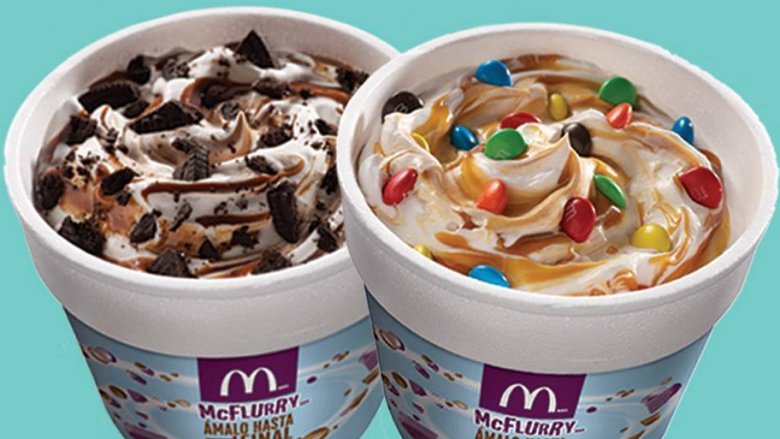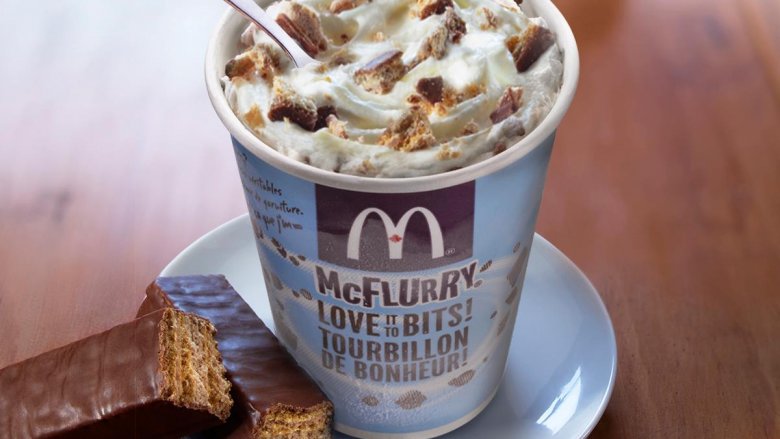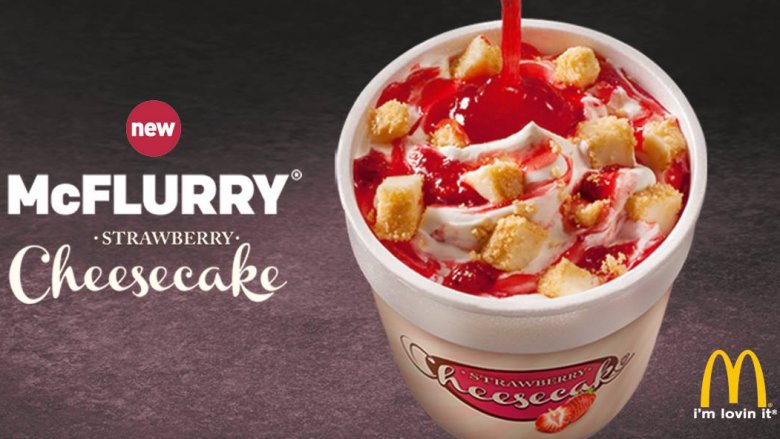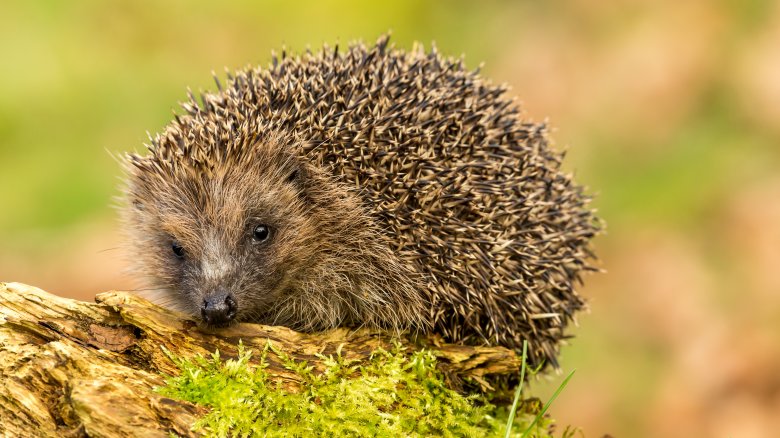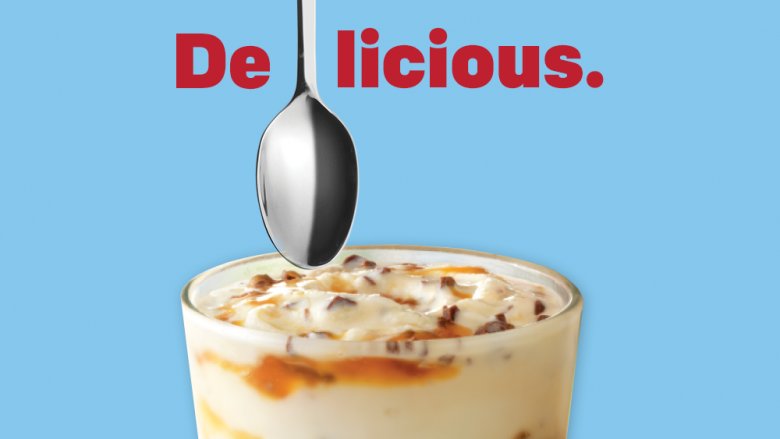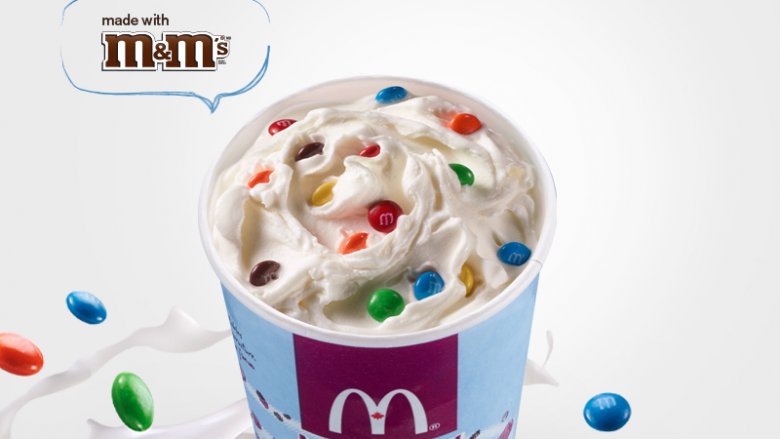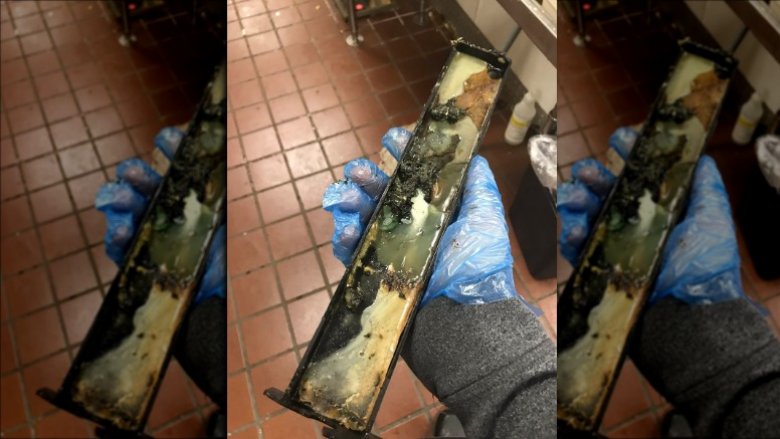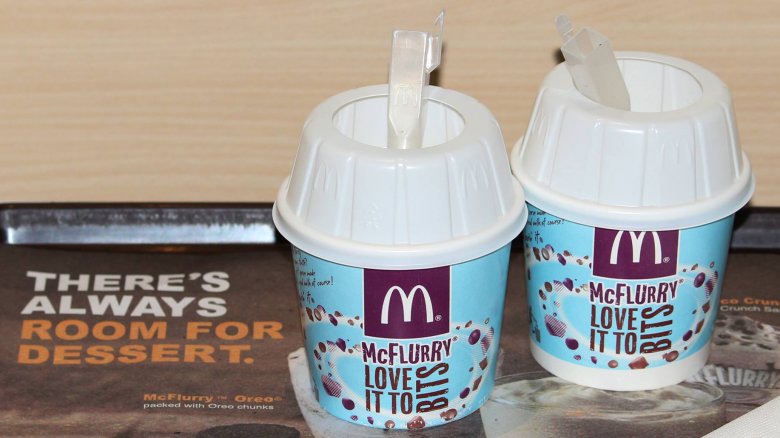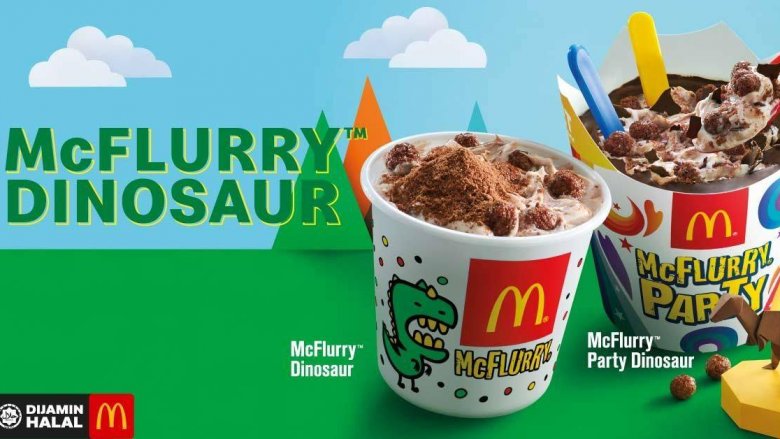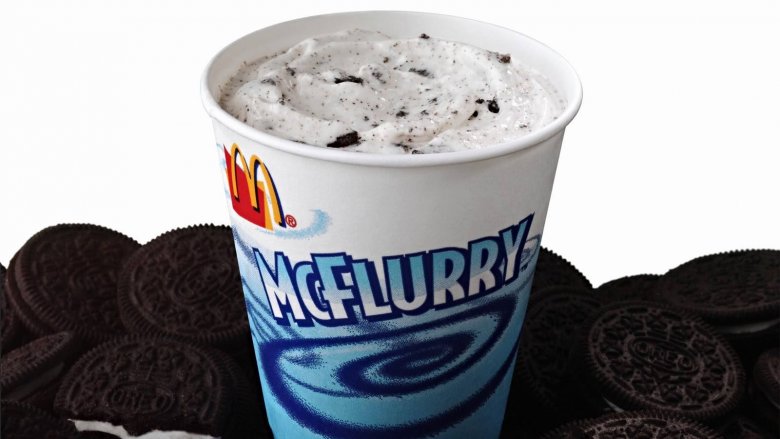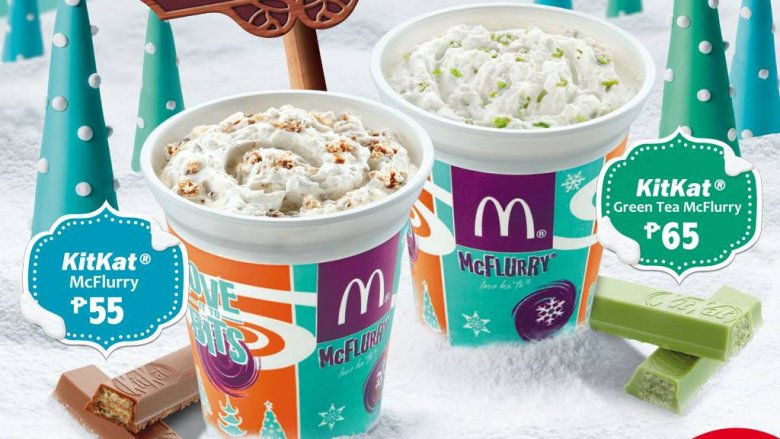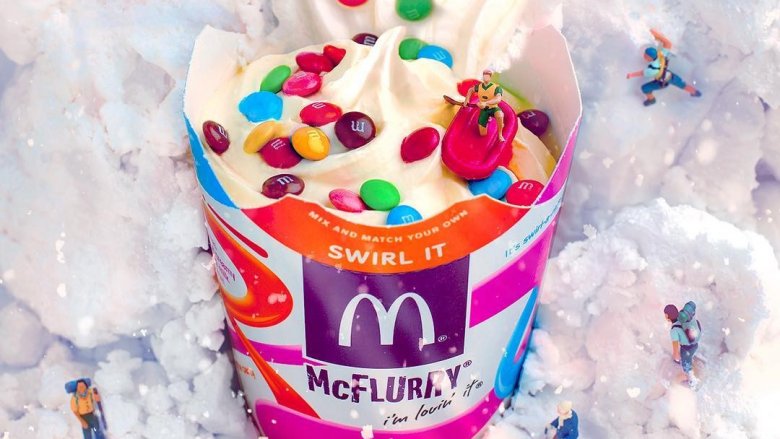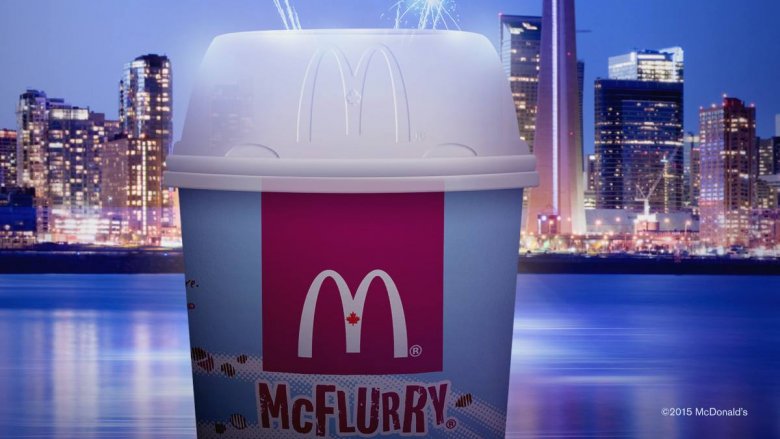The Untold Truth Of McDonald's McFlurry
No trip to McDonald's is complete without a McFlurry. Sure, everyone has a favorite, a go-to flavor, but most people would be hard-pressed to name one they didn't like. How can you go wrong with candy and soft-serve, blended together in a cup full of sweet deliciousness?
But do some digging, and you'll find there's actually a lot you don't know about this iconic sweet treat from the nation's most popular fast food chain. Did you know they've been the center of social media and pop culture controversy, by any chance? Or that they're actually a massive threat to an entire species? And did you know that if you go outside of the US, there are a ton of funky international varieties that totally make a trip to McD's worthwhile, even if you're in the most exotic of countries?
It doesn't matter how many McFlurry's you've had or how often you get them, there's still a lot you don't know about this fun soft serve treat. Let's change that.
It was invented in Canada
McDonald's might have come from the U.S., but America can't take credit for everything that's good and wholesome about the menu under the Golden Arches.
The McFlurry was actually invented in Canada, and it's younger than you might think. A franchisee named Ron McLellan is the one you can thank for his ingenuity, as he invented the McFlurry at his location in Bathhurst, New Brunswick, in 1995. (To put that in perspective, that's the same year Friends was just entering a second season.)
According to CTV News, the original location takes their connection to the McFlurry very seriously. For the 20th anniversary of their creation, they set up a "fake blizzard" over the dessert's birthplace and handed out samples of a red-and-white, anniversary-themed McFlurry. (Please, no one tell Dairy Queen.)
McLellan remained modest through it all, saying, "I never expected that my creation would circle the globe with countries mixing together their own unique flavors."
There are a ton of funky international flavors
The McFlurry has made it onto the menu in around 99 countries (via CTV News), and they're all putting their own unique spin on this versatile sweet treat. And some are getting super creative.
In 2016, The Independent was reporting to U.K. residents that yes, the Cadbury Creme Egg McFlurry was returning to McDonald's menus — something they were already enjoying in Australia. That sounds delicious, right? That's just the start of it.
Japan, says The Loop, has a pretty incredible Matcha McFlurry, that's just as green as you'd expect. Head to Argentina and you can pick up a Vauquita McFlurry, which is filled with dulce de leche and chocolate. For their summer menu of 2018, South Africa added a lime and chocolate McFlurry (via Business Insider), and according to Food & Wine, if you happen to be in Indonesia, you can choose between coconut charcoal and a strawberry cheesecake. Hop over to Thailand for a tiramisu version, then stop in at the Philippines for a green tea KitKat dessert.
And Australians have been combining two menu items for a long, long time in a menu hack that's proved so popular McDonald's opted to release it as an official menu item (via News.com.au). It's almost so painfully American it's shocking the U.S. hasn't gotten it, and it is — of course — the Apple Pie McFlurry.
They're deadly... to hedgehogs
In 2006, The Independent was finally able to report that a long-running U.K. campaign to get McDonald's to change the design of their McFlurry lids had succeeded. It was led by one of those unlikely of groups: the British Hedgehog Preservation Society, and their 12,000-odd members.
It all started in 2001, when a postman found a hedgehog stuck in a container. Attracted by the sweet smell of leftover ice cream, hedgehogs would crawl in partway through the lid's opening, but then couldn't back out because of their spines. Their fate? Death, unless rescued from the inevitable starvation, dehydration, or blindly wandering into traffic, waterways, or other deadly situations.
In true British fashion, the society rallied their members to appeal to the fast food giant for a redesigned lid... but politely. It worked. In 2006, McDonald's announced they would be spending a massive amount of money on the redesign and rolling out new lids, and it wasn't just in the U.K. McDonald's followed suit in Germany in 2008, too (via Spiegel Online), helping prevent the deaths of countless western European hedgehogs (like the one pictured) who are often led astray by their sweet tooth. Turns out, we humans have that in common with them.
The huge 30 Rock product placement controversy
Remember 30 Rock? The show was huge, but it wasn't without controversy — especially, says AdAge, when it came to their use of product placement. Most of it was done in a tongue-in-cheek sort of manner, and it was pretty obvious what they were doing. It was less obvious during an episode where Alec Baldwin and Salma Hayek's characters had a reconciliation that revolved around a McDonald's, and the McFlurry was front and center. It was even called "the world's greatest dessert," and that's a big stance for a television show to take.
Because people can never have too many things to be outraged about, social media was up in arms over the inclusion of the McFlurry. Why? Who knows. Blatant product placement without the snarkiness, perhaps? At any rate, NBC, McDonald's, and Tina Fey all had to issue statements saying that 30 Rock hadn't been paid for using the McFlurry and McDonald's, and that the fast food chain had not only known about it, but had reviewed the script and given it the go-ahead.
Fey said (via TV Guide) that not only was it not product placement, but they were slightly worried about getting sued. And then added, "Also, the upcoming story line were Liz Lemon starts dating Grimace is just based on a recurring dream I have. Seriously, though, it's not product placement."
M&M McFlurries almost disappeared
We're pretty used to bad news, and in 2016, the world almost got just a little bit darker when Reuters reported that Mars Inc. was considering putting an end to their long-running partnership with McDonald's. It would have meant the end of the M&Ms McFlurry, and that would have been the very definition of a travesty.
So, what gives? According to insiders, Mars was reaching out to all of the fast food chains that carried their products, because they were concerned that the desserts their candy was featured in — like the McFlurry — was going against the messages of moderation they were trying to send. Take a peek at the nutritional information McDonald's has posted about the M&M McFlurry and it's it's pretty dismal. It includes 126 grams of sugar, and that's way more than anyone's recommended daily allowance. (According to Healthline, men should have no more than 37.5 grams of added sugar per day, and women should have no more than 25 grams.)
At the time, Mars was refusing to go into any details with the media, and given that the M&M McFlurry is still around — and still has an awfully large amount of sugar — it's safe to say we all know how the talks ended.
THAT photo of the McFlurry machine
Even the biggest fans of McDonald's and the McFlurry had to admit their stomachs turned just a little bit in 2017, when Business Insider says a teenage employee only identified as "Nick" kicked off a serious uproar. It started when he posted some seriously disgusting images that he claimed showed the pretty standard condition of their ice cream equipment (and continued to try to stir up trouble when he posted photos of pre-cooked food). The machine was apparently caked with goopy mold, and the implication was that customers were being served food from nasty equipment.
McDonald's did issue a formal statement, and said the picture wasn't at all what it appeared to be. According to spokespeople, the tray was actually designed to catch any leaks that might happen from the machine's internal components, and it wasn't part of the food service or prep surfaces at all. The owner of the McDonald's location where the photos were taken also responded, saying they were serious about health, safety, and employee training — and had a long record of clean inspections.
Nick, on the other hand, was not only fired but banned from that particular McDonald's.
Why the spoon looks so weird
Let's talk about that McFlurry spoon. It seems like a massive waste, right? It's huge and it's oddly shaped, after all, and why use something so strange when you'd think a regular spoon would do perfectly well for a soft-serve dessert?
Cosmopolitan was asking the same thing, and picked up on an explanation one employee posted on Tumblr. According to The Waiting Platypus, there are a few different reasons for the design. They start with the fact that it's not just a spoon, it's used to actually stir all of that chunky goodness into the soft serve. It attaches to the machine, and that's why it's extra-long. That's why that square shape is there, too, to make it stronger and prevent it from snapping as it's whirring about in your McFlurry.
They add that, according to their assertions, it's hollow because it saves on plastic while not compromising on strength, and it also insulates your hand against the cold. As a bonus, the square shape is also easier to pack and ship, and when they're sending out so, so many all over the world, that's a big deal. Now you know!
The huge change no one noticed
Many fast food places are making a shift toward removing things like artificial flavors and colors from their ingredient lists, and McDonald's is no exception. When it came to their soft serve and — by extension — the McFlurry, the fast food giant didn't give anyone a chance to criticize any perception of new flavors: they didn't tell anyone until the new recipe had been in use for around six months.
According to McDonald's official statement (via CNBC), their vanilla soft serve already had no artificial preservatives or colors, and now they were removing artificial flavors The recipe change (which impacted around 60 percent of their desserts) began rollout in fall of 2016, and by the time they actually announced it in May 2017, the full switchover was nearly finished.
The plan was, in part, to try to win back some of the 500 million customer visits that had disappeared since 2012. Advertising a product free of artificial flavors is just half the battle, and McDonald's said they went above and beyond to make sure there was no change in the taste. Given that it went unnoticed for so long, it's safe to say they succeeded.
The U.S. version is worse for you
If you go to McDonald's in the U.S. and in the U.K., you can order an Oreo McFlurry in both places. But what you're going to get is definitely not created equal, and a quick peek at their nutritional information reveals you're going to be getting a dessert that's definitely worse for you on one side of the Atlantic.
Order a regular Oreo McFlurry in the U.S., and it'll be packed with 510 calories, 17 grams of fat, and a whopping 64 grams of sugar — about twice the recommended daily allowance for added sugars (via Healthline). Sure, dessert has a reputation as not being the healthiest meal of the day, but even McFlurry fans can agree that's not the best for you.
Order a regular Oreo McFlurry in the U.K., though, and you'll get a very different dessert. There, you'll be getting 267 calories, 9.1 grams of fat, and 34 grams of sugar. We know, right?
Part of the difference comes from a very different outlook on portion sizes. According to Nutritionix, a standard U.S. McFlurry is 285 grams while across the pond, a regular size is only 150 grams (via Gizmodo). And that wasn't always the case — with an ever-increasing awareness about portion sizes and the impact it has on health, McDonald's downsized their regular McFlurry from 170 grams to 150 in summer of 2018, along with adding a 75-gram option. Should the U.S. follow and downsize as well?
Here's why the machines are always down
Anyone who's tried to get a McFlurry has probably heard the dreaded words: "Sorry, the machines are down." What gives? It happens all the time — in 2017 The Wall Street Journal reported that it had spawned so many complaints and conspiracy theories that they felt they just had to investigate.
For all of us.
And they found there's actually a couple things at work here, and they all go back to the machines that make the soft serve. If there's no ice cream, there are no ice cream desserts, and that includes the McFlurry.
One problem is that the ice cream machines are really, really hard to clean. Every night, they go through an automated cleaning program that takes four hours to complete — and that's a lot of down time. More than that, it also takes an 11-step process just to get the machine prepped for the cleaning cycle, and that involves a lot of disassembling, soaking, cleaning, and wiping. According to employees, if they were at any stage in even the beginning of the process, they would just tell customers the machine was down. And, if they just finished cleaning it... sometimes, it'll just be "down." At 24-hour McD's, the time the machines are down for cleaning is even more noticeable and, well, it's just going to have to happen sometime.
Some franchisees have another problem: the soft serve machines actually are broken. Among McDonald's staff, they're well-known for being incredibly finicky, poorly designed, and easily damaged. Some surveys of locations suggest as many as 25 percent have non-functional machines at any given time.
The sad state of Australia's McFlurry
Business Insider says that it was around 2015 that Australians started to notice a disturbing thing happening with the Down Under version of the McFlurry: they weren't actually, well, flurried. Customers expecting to find candy and cookie bits mixed all through their dessert were sorely disappointed, and they were more likely to find the bits of goodness just thrown on top.
The outrage was real, and when BuzzFeed investigated, they found that it wasn't just a few employees being lazy or a handful of customers being overly demanding, it was McDonald's — or Macca's, as it's known in Australia — completely overhauling the McFlurry.
According to their official statement, "The machines took up considerable space in our kitchens, so the decision was made that they would be hand stirred — with love — by our crew. If you like yours a little more 'flurried', let the crew know and they will be sure to give it a more vigorous stir."
But... isn't a non-flurried McFlurry just a sundae with some fun toppings?
Canada's potentially dangerous McFlurry
In 2017, Canada's McDonald's found itself in a weird position. At the same time they were trying to advertise their new, all-day breakfast menu, they were also facing a huge backlash for their addition of a new McFlurry to the menu. Normally, a new McFlurry flavor couldn't be a bad thing, but this was a Skor McFlurry. For anyone not familiar with a Skor bar, it contains nuts.
Until then, says the Financial Post, McDonald's had been pretty widely viewed as safe for those who had nut allergies. Food Allergy Canada was among the organizations who petitioned McDonald's, asking them to get rid of the option because of the likelihood of cross-contamination. (It's also important to mention that McDonald's has never actually said they're nut-free, it's just been the long-standing perception among allergy sufferers.) Previously, any nuts that were served came individually packaged, and the Skor McFlurry was a major departure from that.
McDonald's wasn't having any of it, though, and issued a statement in support of the newest McFlurry and deriding the above-and-beyond standards groups were calling for. It read, in part: "To hold McDonald's alone to this standard is unreasonable and beyond anything required of any other brand in our industry." At least they said how they really feel!
